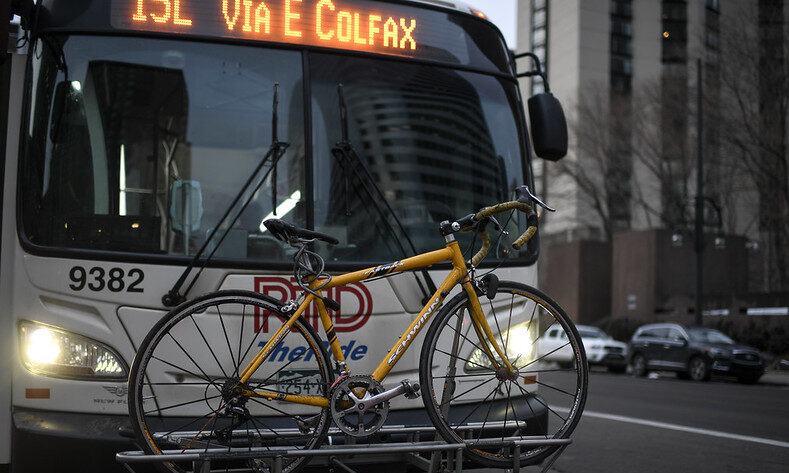Back on Track: How Will the RTD Board Respond to COVID-19?

It’s no secret: RTD is in a financial bind and has been for some time. In 2019 the agency had to make $40 million worth of cuts to the 2020 budget while dealing with a shortage of operators that led to service reductions. This year RTD has lost tens of millions in fare revenue due to the COVID-19 pandemic and is currently facing a $215 million shortfall for 2021. The majority of RTD’s revenue comes from sales tax and passenger fares, provisions in the bill that established RTD in 1969. So when they stopped collecting fares April through July, a large portion of their revenue for the year was gone.
When Denver entered stay-at-home orders in early March, fears of the disease, reduced service, and changing work habits drove commuters away from transit, with ridership initially falling 70%; usage has increased slightly since then but still hovers around 40% of pre-pandemic figures. As a result, RTD cut bus and rail services by 40%, reducing services on lines with already low ridership.
In May, RTD released a survey to get feedback from riders to assess public comfortability regarding public transit in the time of the pandemic. At the time, responders viewed riding RTD as the least safe activity compared to grocery shopping, going to the pharmacy, visiting friends or family, and exercising outside. Many responded saying they would “wait to see what happens” with the virus before deciding if they’ll return to RTD. When asked what RTD could do to make riders feel safe, many had similar answers. “Trains and buses need to be sanitized and masks should be required,” one person responded. “Then the number of passengers needs to be limited.”
Currently, all riders are required to wear a mask while on the bus or train, and RTD has limited the ridership capacity on buses. RTD has installed plexiglass on 87% of their bus fleet to protect bus operators and, according to the RTD website, rail and bus vehicles are cleaned daily by “wiping down handrails and other high-touch surfaces with an industrial-strength disinfectant/antibacterial cleaner.”
Nevertheless, RTD’s current system is flawed. There is little to no enforcement of people wearing masks and social distancing on vehicles and oftentimes bus operators are the ones holding riders accountable. “Drivers need to drive the bus,” said Joe Lamers, who leads the RTD Citizens Advisory Committee. “We have to make sure drivers are not the enforcers.”
Buses that fill to capacity are bypassing stops where more riders are waiting to board. Operators can call for backup buses on popular routes but this requires on-call buses and operators, potentially costing the agency extra money if operating costs for extra buses and operators are not recuperated through ridership fares.
Even more alarming for RTD’s immediate future are the rising COVID numbers in Colorado and impending stretches of cold weather. RTD needs to prepare for the winter months and the impact of increasing COVID cases in the state, each of which could significantly impact ridership and the health and safety of operators as well as the region’s overall activity—elected officials have recently warned that Denver is approaching a shutdown if the pandemic is not brought under control.
In a press conference held by the City on Oct. 27, Bob McDonald, Executive Director for the Denver Department of Public Health and Environment, addressed the current situation in Denver. “We are already moving towards a stay-at-home order if we don’t get this under control,” McDonald said.
Above: Denver COVID-19 dial
What steps can the RTD board take to confront the looming and intertwined hardships of COVID-19, decreased public trust in the agency, massive financial shortfalls, and plummeting ridership numbers? According to Deya Zavala, Executive Director of Mile High Connects, RTD is looking to increase air quality in buses and trains. “We’ve heard they (RTD) are exploring air filtration systems to minimize air transmission of the virus – this is a great take on just another strategy to rebuilding trust.”
The challenges facing RTD are immense and complex, building on each other to create a deadly chain of priorities. The COVID pandemic has exacerbated an already-bad situation for RTD. Addressing the financial woes requires increasing ridership, which requires increasing public trust and providing service where it’s still being used, which requires effective management of the COVID-19 pandemic so that people are still moving around for work and leisure. Pending the region doesn’t enter another stay-at-home order, the board must take steps to increase ridership, which hinges primarily on increasing public trust in the safety of using transit and increasing service along high-usage lines.
“They need to promote transportation as a clean alternative to get people back on the bus. To make sure the riders that have left are coming back,” said Jamie Lewis, an accessibility advocate with the Colorado Cross Disability Coalition and transit-dependent resident. The board’s position in RTD allows them to make decisions around the development of rail stations, oversee service changes and pass the agency’s annual budget.
“The board should continue to prioritize operator and passenger public health safety, advocating at the federal level for resources to support public transit’s role in a long term, sustained economic recovery from COVID,” added Zavala. None of this is easy, but their priority moving forward is clear: ensure that daily transit is safe, affordable and convenient in highly concentrated areas of transit-dependent people.
Get Streetsblog Denver’s weekday headlines delivered to your inbox. Sign up for our e-mail digest



